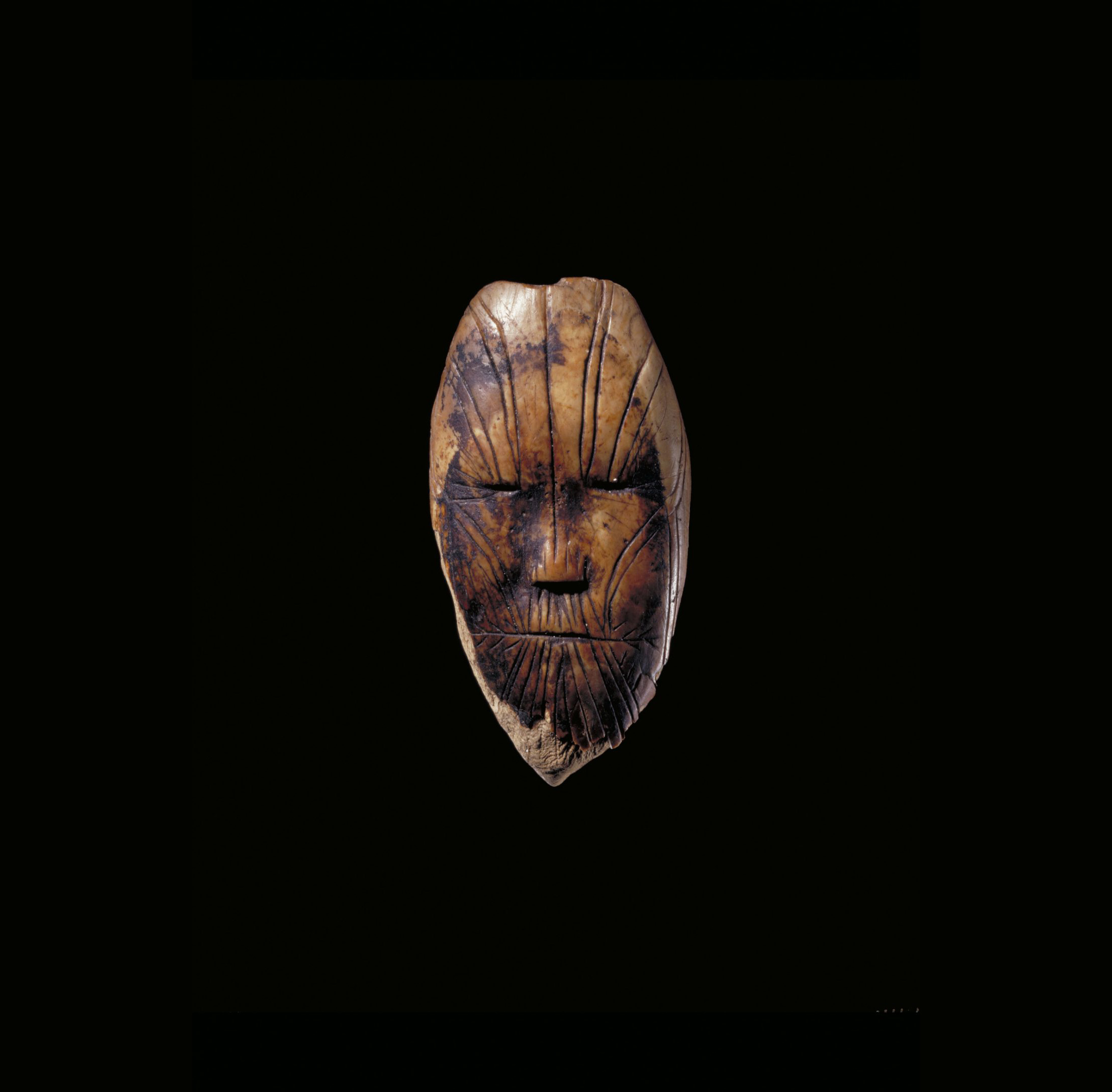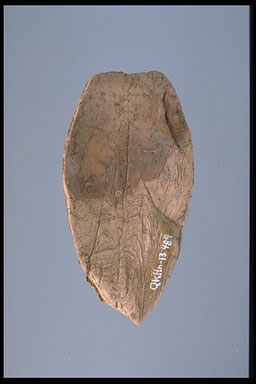Maskette (The First Face)
Artifact
Image
Video
Audio
 Activities
Activities
LOOK
Look at the carving. Before you read the historical context, try to answer the following questions:
- What is the object, or what does it represent? What makes you think that?
- Who made this object? What makes you think that?
- What’s the object made of?
Now read the historical context, and see whether your answers were correct.
THINK
Based on what you see in the carving, what information can you gather or conclude? (E.g.: I see a carving of a face, so I think the person who made it was an artist.)
Extension: What sources, or types of information, might help verify your conclusions? Where would you look for such sources?
THINK
In order to use this carving as a piece of historical evidence, it is important to understand the context in which the carving was made. Part of understanding comes from taking a historical perspective. Read the historical context and think about what life was like for people at the time this carving was made. How do you think their circumstances impacted the materials used to create the carving?
Possible answer: The person that carved the First Face lived in the circumpolar regions, which limited the materials they had access to. This carving is made of walrus ivory which was available to them.
DO
Do some external research on Inuit tattooing traditions today. Try to find three different sources (e.g., newspapers, books, videos). Share your findings with a friend. How do your findings add to your understanding of the ivory carving?
Details
 Materials
Materials - Ivory
Historical Context
Choose one of the three levels below to match your needs.
- This carving is between 3,900 and 3,600 years old. It is made of ivory and is the oldest depiction of a human face in North America.
- It is likely showing a woman’s face. The lines carved on her forehead, cheeks and chin are likely facial tattoos, which some Inuit women have today.
- The people who carved this face lived and thrived in the harsh conditions of the Arctic.
Around 4,500 years ago, people started to move from Alaska to the Arctic. These First People were well adapted to the climate and used specialized tools to thrive for thousands of years.
This carving was created by these people. It is between 3,900 and 3,600 years old. It is made of ivory and is likely the oldest depiction of a human face in North America. The carving is probably of a woman. The lines on her forehead, cheeks and chin could be facial tattoos, similar to traditional tattoos worn by some Inuit women today.
Around 4,500 years ago, people started to move from Alaska to the harsh tree-less landscape of the Arctic. These First People were well adapted to the climate and used specialized tools to thrive for thousands of years. However, by about 700 years ago, they had disappeared, leaving no descendants.
Throughout the thousands of years these First Peoples lived, they fostered many artistic traditions. This carving is between 3,900 and 3,600 years old. It is made of ivory and is likely the oldest depiction of a human face in North America. It may represent the face of a woman. The lines carved on her forehead, cheeks and chin are likely facial tattoos. Some Inuit women today have facial tattoos, showing the longevity of the tradition.
- This carving is between 3,900 and 3,600 years old. It is made of ivory and is the oldest depiction of a human face in North America.
- It is likely showing a woman’s face. The lines carved on her forehead, cheeks and chin are likely facial tattoos, which some Inuit women have today.
- The people who carved this face lived and thrived in the harsh conditions of the Arctic.
Around 4,500 years ago, people started to move from Alaska to the Arctic. These First People were well adapted to the climate and used specialized tools to thrive for thousands of years.
This carving was created by these people. It is between 3,900 and 3,600 years old. It is made of ivory and is likely the oldest depiction of a human face in North America. The carving is probably of a woman. The lines on her forehead, cheeks and chin could be facial tattoos, similar to traditional tattoos worn by some Inuit women today.
Around 4,500 years ago, people started to move from Alaska to the harsh tree-less landscape of the Arctic. These First People were well adapted to the climate and used specialized tools to thrive for thousands of years. However, by about 700 years ago, they had disappeared, leaving no descendants.
Throughout the thousands of years these First Peoples lived, they fostered many artistic traditions. This carving is between 3,900 and 3,600 years old. It is made of ivory and is likely the oldest depiction of a human face in North America. It may represent the face of a woman. The lines carved on her forehead, cheeks and chin are likely facial tattoos. Some Inuit women today have facial tattoos, showing the longevity of the tradition.
Summary
- This carving is between 3,900 and 3,600 years old. It is made of ivory and is the oldest depiction of a human face in North America.
- It is likely showing a woman’s face. The lines carved on her forehead, cheeks and chin are likely facial tattoos, which some Inuit women have today.
- The people who carved this face lived and thrived in the harsh conditions of the Arctic.
Essential
Around 4,500 years ago, people started to move from Alaska to the Arctic. These First People were well adapted to the climate and used specialized tools to thrive for thousands of years.
This carving was created by these people. It is between 3,900 and 3,600 years old. It is made of ivory and is likely the oldest depiction of a human face in North America. The carving is probably of a woman. The lines on her forehead, cheeks and chin could be facial tattoos, similar to traditional tattoos worn by some Inuit women today.
In-Depth
Around 4,500 years ago, people started to move from Alaska to the harsh tree-less landscape of the Arctic. These First People were well adapted to the climate and used specialized tools to thrive for thousands of years. However, by about 700 years ago, they had disappeared, leaving no descendants.
Throughout the thousands of years these First Peoples lived, they fostered many artistic traditions. This carving is between 3,900 and 3,600 years old. It is made of ivory and is likely the oldest depiction of a human face in North America. It may represent the face of a woman. The lines carved on her forehead, cheeks and chin are likely facial tattoos. Some Inuit women today have facial tattoos, showing the longevity of the tradition.


